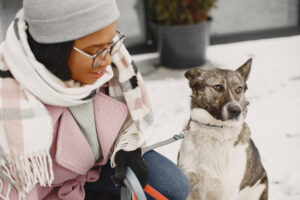- Full Text
- Published: 2016
- Original Authors: Clive Wynne, Lisa Gunter, Rebecca Barber
This Research in a Nutshell
1. Breed Labels Influence Perceptions: The study examines how breed labels affect human perceptions and assumptions about a dog’s personality. It found that breed labels create bias in people’s perceptions of dogs.
2. Lack of Correlation Between Breeds and Behavior: The research did not find significant correlations between dog breeds and behavior, suggesting that breed stereotypes are unsupported by scientific evidence.
3. Hypothesis on Removing Breed Labels: Gunter et al. correctly hypothesized that removing breed labels from information given to potential adopters could increase adoption rates for all dogs in a shelter.
4. Consistent Findings Across Studies: Despite different methodologies and survey samples, all three studies supported the hypothesis that breed stereotypes negatively influence people’s perceptions of individual dogs.
5. Positive Impact of Removing Breed Labels: Study 4 demonstrated that removing breed labels in a large shelter led to increased adoption rates for all dogs, particularly those considered to have American Pit Bull Terrier (APBT) ancestry. This suggests that eliminating breed labels can improve rehoming outcomes.
In Summary: These findings highlight the importance of addressing breed biases in the adoption process and the potential benefits of removing breed labels to ensure fair treatment and increased adoption opportunities for all shelter dogs.
Full Analysis
We include this paper because it examines the influence of a breed label on human perceptions and assumptions about that dog’s personality. The authors looked at this influence from 3 distinct perspectives and concluded that breed labels created bias in humans, unsupported by the research regarding any correlations between breeds and behavior. Based on this, Gunter et al hypothesized that removing breed labels from information provided to potential adopters would increase adoption rates for all dogs in a given institution and conducted a 4th follow-up study to test this. One of the strengths of these studies is that all 3 supported the same hypothesis, that breed stereotypes influence people’s perceptions of individual dogs, usually to the detriment of those individuals. This was true even though the methodologies, the actual research questions addressed, and the survey sample differed.
Study 1 surveyed a combination of college students and a Reddit based internet sample to look at general population perceptions of dogs with the appearance of purebreds . Studies 2 and 3 surveyed actual potential adopters at a large shelter, using still photos in study 2 and videos in study 3. Respondents compared their perceptions of attractiveness, personality traits, and adoptability. In study 1, participants made 2 kinds of comparisons: first among 3 dogs, each of whom was morphologically consistent with a purebred dog: either a Border Collie, a Labrador Retriever, or an American Pit Bull Terrier (APBT). The APBT was rated as less desirable on the various metrics used, such as “aggressiveness,” “friendliness,” even “trainability.” However, when the same dog images were paired with people of various demographics, the results changed. When the APBT was paired with an elderly woman or a child, the differences in how the dog was viewed plummeted. The primary limitations of this study are in the populations studied, neither of which can be presumed to be representative of people likely to adopt dogs: college students who are a very specific population, and internet survey respondents, where any self-selection bias cannot be determined. In addition since the first 2 breeds were not used as control groups in the human/dog pairing photos, so we cannot determine what effect that might have had on their ratings.
Study 2 took a different approach, directly investigating whether a link could be found between adoptability and labeling dogs by breed. Respondents rated photos of dogs, all of whom bore some morphological resemblance to APBT’s. Half of the dogs had been labeled as APBT’s in information available to adopters. The researchers then paired each of these photos with a photo of a lookalike dog, in terms of morphology, age, and weight) who had either not been labeled by breed or labeled a different breed by the shelter. Both groups of photos were rated the same by the potential adopters on various qualities like friendliness and intelligence. No difference in general adoptability or desirability was found. But the actual length of stay (number of days available for adoption before being adopted) was 3 times as long for the dogs labeled as APBT’s. The study was small, but the difference in outcome for the labeled vs. unlabeled dogs is striking.
Study 3 applied the same principle to the more ambitious matching of videos of dogs in shelter kennels with lookalikes, since this is how potential adopters actually view dogs. While unlikely to be purebreds, all had some morphological similarities to APBT’s. The matched pairs were rated as equally desirable and adoptable when viewed with breed labels, but when an APBT breed label was added, the same dog rated as less desirable.
Study 4 looked at what actually happened to adoption in a large open-access shelter when breed labels were removed. Their findings were consistent with the hypothesis that this would benefit outcomes for all the dogs. This is exactly what happened, with adoption live outcomes increasing for all dogs, most dramatically for those considered to have APBT ancestry by shelter staff, for whom adoption rates went up and euthanasia rates correspondingly went down by 12%. While this is still a correlation study, meaning the researchers cannot claim that removing breed labels, rather than some other, or a combination of factors, caused the improvement, the cumulative effect of these varying approaches to the effect of breed bias on rehoming issues cannot be ignored.




